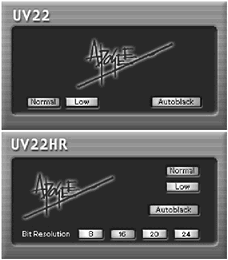About Dithering
| [ LiB ] |
About Dithering
Using 24-bit resolution and above during the production process helps enhance the dynamic qualities of your project, while reducing the possibility of audible noise levels. It also increases the signal-to-noise ratio, which is the level of the noise with no signal applied expressed in dB below a maximum level. As you saw earlier in this book, this ratio (in theory) is around 146 dB in a 24-bit recording and 194 dB in a 32-bit recording. Such a ratio suggests that when you record a sound using 32-bit resolution, your noise floor is at 194 dB, which is inaudible and negligible by any standards. Of course, in practice, you rarely get such impressive signal-to-noise ratios due to many noise-generating elements before and after the sound card's converters, but the ratios are consistently more impressive when using higher bit rates. Unfortunately, when you mix down to transfer to a 16-bit DAT recorder, or want to record it on a CD for compact disc players, you need to bring this precision down to 16-bit.
There are two methods used to accomplish this: truncating and dithering. Truncating simply cuts the lower part of the digital word that exceeds the 16-bit word length. Here's an exampleif you have a sample that would be stored in 24-bit, it looks like this:
-
1110 0111 1100 0111 0011 1100
Now, if this sample were truncated to 16-bit, it would look like this:
-
1110 0111 1100 0111
What happened is that the last eight digits were cut off. These last eight digits are often reverb trails dying in the noise, or harmonics of instruments at low-level intensities. Cutting them off usually adds what is known as quantizing errors . This quantizing error sounds unnatural to human ears.
The solution is to add a special kind of random noise to the sound when you need to bring down the resolution. This random noise is dither noise. What it does is to change the last bit in a 16-bit word randomly , creating a noise at 98 dB, which is pretty low. But, in reality, this noise is low enough to perceive sounds at -115 dB. Dithering is not needed when you are working in a 24-bit or 32-bit environment. So keep this for the end.
How To
To set up dithering on your final mixdown :
-
Open the Mixer window (F3 is the default key command).
-
Because dithering is and should be the last step in your mixdown process, it should only be added when you are preparing the final mixdown to a 16-bit sound file. Because of this, load the UV22 dither plug-in (in Cubase SL) or UV22HR (in Cubase SX) in the last Insert (Number 5 in SL or Number 8 in SX). The UV22 and UV22HR plug-ins are located by default in the Other VST effect's submenu (see Figure 15.1).
Figure 15.1. The UV22 dither processor above and its UV22HR counterpart (available in Cubase SX only) below.

-
Make sure the effect is enabled.
-
In the effect's Edit panel, select the Normal Auto preset. This will suit most of your dithering needs.
With this final option set, you are now ready to export your mix to an audio file.
| [ LiB ] |